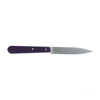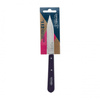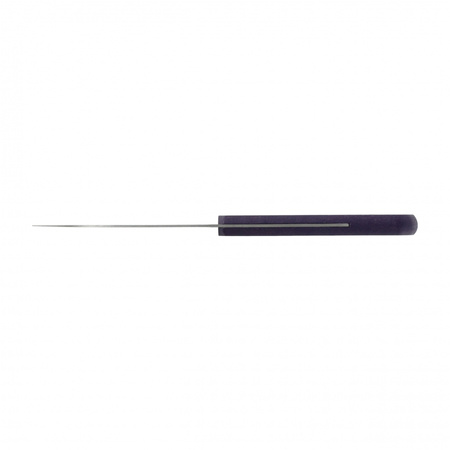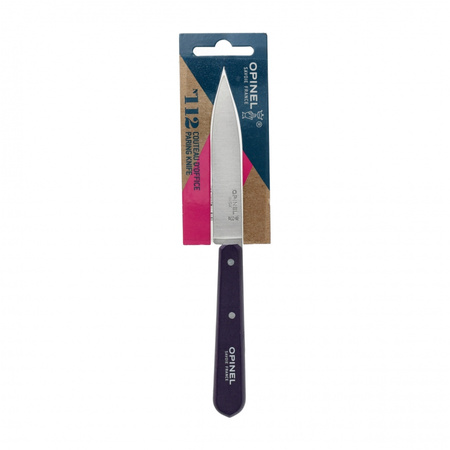Opinel 112 Paring Knife purple
Opinel 112 Paring Knife - universal kitchen knife for precision tasks
Opinel 112 Paring Knife is a handy, lightweight and extremely effective kitchen knife that is ideal for peeling, slicing and preparing vegetables and fruits. Thanks to its excellent cutting properties and comfortable wooden handle, it is a tool of choice for professional chefs and home cooking enthusiasts alike.
Precision, sharpness and reliability
Head length of 100 mm was made of swedish Sandvik 12C27 steel, valued for its high corrosion resistance, durability and low susceptibility to wear and tear. Thanks to the fine carbide structure, the blade provides an aggressive, smooth cut while maintaining sharpness for a long time. Maintenance is minimal - just wipe them dry after use.
Comfortable and safe use
Natural handle made of hornbeam wood has been contoured to lie well in the hand and guarantee full control of the knife. Durable metal rivets solidly connect the facings to the mandrel, resulting in a stable, durable structure.
The purple color adds a modern touch to the knife and makes it stand out from classic kitchen tools.
Ideal for everyday kitchen work
This versatile knife will be great for use during:
peeling vegetables and fruits,
slicing and chopping fine ingredients,
preparation of meats, cheeses and vegetables,
light work during picnics and outings.
It's a practical tool to always have on hand - whether you're preparing a quick breakfast or a demanding meal for the whole family.
Technical data
Hardness of steel: 55-57 HRC
Steel type: sandvik 12C27 stainless
Certificates: PEFC
Handle color: violet
Handle material: hornbeam wood
Corrosion resistance: high
Dishwasher safe: not
Overall length: 198 mm
Blade length: 100 mm
Handle length: 98 mm
Application: knife for peeling, precision work, cutting vegetables, fruits, cheese, meats; kitchen and picnic knives
Warranty: lifetime manufacturer's warranty
Manufacturer: Opinel, France
EAN: 3123840031168
List of knife safety warnings based on requirements
Regulation (EU) 2023/988 on general product safety
(GPSR):
* Risk of injury: Use the knife carefully and always hold it by the handle. The blade is
very sharp and can cause serious cuts. Don't try to catch a falling
knife.
* Safe storage: the knife should be stored in a safe
place, out of reach of children and unauthorized persons. Use a blade guard if
is available.
* Use as intended: Do not use the knife for purposes for which it is not
intended, for example, for opening cans or loosening screws. This can lead to
knife damage or injury.
* Caution when cleaning: Use caution when cleaning the knife,
to avoid cuts. Do not use aggressive cleaning agents that can
damage the blade.
* Blade maintenance: Sharpen the blades regularly to keep them in good condition. Blunt
knives are more dangerous than sharp ones because they require more force, which
increases the risk of slipping.
* Transporting the knife: When transporting the knife, make sure the blade is secured,
for example, by using a vagina or sheath. This prevents accidental injuries.
* Keep your knife clean: Clean the knife regularly to remove any food debris
or other contaminants. This ensures safe and hygienic use.
* Do not modify the knife: Do not try to modify the knife or repair it yourself,
if you don't have the right skills. This can lead to damage to the knife
or injuries.
* Warning for children: knives are intended for adults only. Do not allow
children to use knives without supervision.
* Disposal: Dispose of used or damaged knives in a safe manner to
prevent accidental cuts.
This product is for adults only, who have knowledge and experience in handling sharp cutting tools. Improper use of the knife can lead to serious injury. The blade of the knife is very sharp and can quickly cut through skin and tissues; so always be very careful when slicing and do not bring your hand close to the cutting edge. To avoid slipping of the knife, it is recommended to cut on a stable and non-slip surface and avoid excessive pressure, which can cause uncontrolled movement of the blade.
Be aware that leaving a knife on the edge of a table, countertop or in easy-to-reach places, especially for children, is a danger. The knife should always be properly secured after finishing work, preferably by putting it down on a stable surface or storing it in specially designed blocks, sheaths or on magnetic strips. Never use a knife for tasks for which it is not intended, such as opening cans or using it as a lever, as this risks both damage to the tool and dangerous accidents.
Blunt blades pose an increased risk of injury because they require more force and tend to slip off the material being cut. Therefore, care should be taken to sharpen the knife regularly to maintain optimal sharpness. It is also necessary to clean and dry the tool regularly to prevent corrosion and bacterial growth. It is recommended to periodically inspect the condition of the handle and blade to detect any cracks, chipping or loosening. If damage is found, the knife should be immediately repaired or replaced with a new copy.
When using the knife, focus solely on the task at hand, avoid talking on the phone or watching TV while slicing, and make sure your work area is well-lit. You are reminded that in some countries or regions there are laws restricting the possession and carrying of knives. Before buying or using a knife, it's a good idea to make sure that using it in your location is allowed under the current law.
Adherence to the above rules will enable safe and efficient use of the knife, minimizing the risk of accidents and ensuring the long life of the tool.











